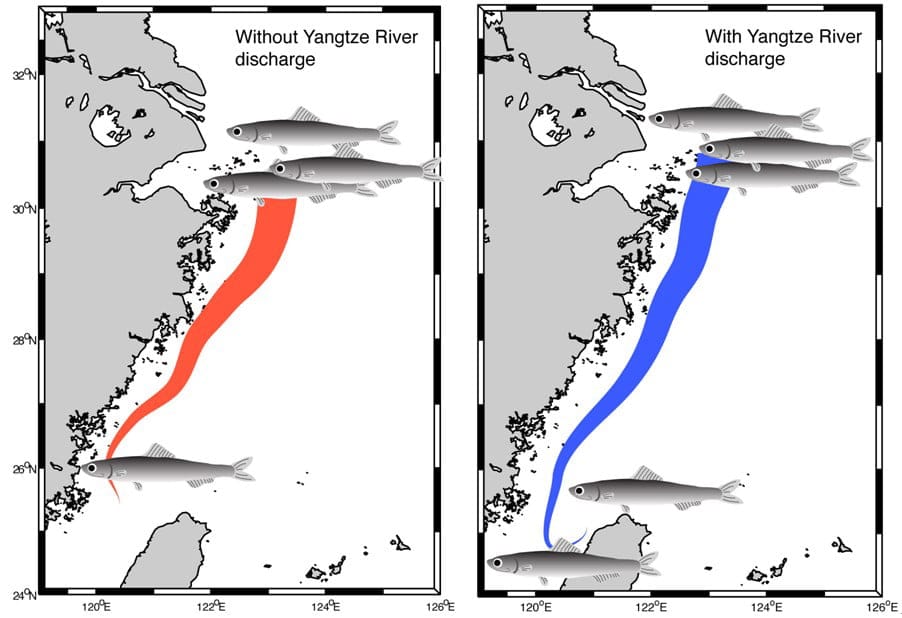長江大壩截流對東海鯷魚產卵洄游可能有負面影響
- 杜貞儀、謝志豪
臺大海洋研究所
- 以魚類行為—物理洋流耦合模式,臺大科學家發現長江建壩後可能對東海日本鯷產卵洄游有不利影響。此研究由臺大海洋所研究生杜貞儀與謝志豪副教授主導,成果刊載於本年度漁業海洋學刊(Fisheries Oceanography)七月號。
- 此篇研究以魚類行為—物理洋流耦合模式模擬日本鯷於東海的產卵洄游。一般而言,在東海的日本鯷,有一個族群每年冬末春初會由東海洄游至台灣附近海域產卵,而這些卵孵化後的仔魚,便是一般統稱吻仔魚的一大部分。由於吻(魚堯)漁業是台灣重要經濟漁業,因此了解日本鯷產卵洄游的機制,對制定漁業資源管理方針將有很大幫助。
- 由於日本鯷成魚並不是主要的漁撈標的物種,不易由捕撈量推斷洄游時間和所經地點,所以本研究使用魚類行為—物理洋流耦合模式進行模擬。其中物理環境部分是由大氣系曾于恒副教授發展的臺灣多尺度海流模式(TaIwan Multi-scale Community Ocean Model, TIMCOM)進行模擬,藉此取得溫度、鹽度、海流速度等多項物理參數,而日本鯷洄游則是以拉氏顆粒追蹤法(Lagrangian tracer tracking),模擬在流場環境下,物體位置隨時間的變化,並考慮魚類游泳速度及游向對移動軌跡的影響。為了模擬三峽大壩造成長江流量減少,進而對東海附近流場造成的衝擊,在研究中設計有長江淡水注入,以及無長江流量的兩組進行比較。結果發現,日本鯷的產卵洄游,極可能受冬季中國沿岸流有無所影響,在無長江流量的情形下,日本鯷可能無法洄游至台灣海域附近。這是因為流量減少可能使由長江口附近沿大陸沿岸南下的中國沿岸流隨之減弱,故使日本鯷族群無法藉著沿岸流幫助洄游至南邊產卵場。這個結果也顯示,三峽大壩完工後的流量減少,可能使日本鯷成功洄游至台灣附近海域的機率降低,進而衝擊台灣的吻(魚堯)漁業。
- Figure 1. Schematic diagram shows the influence of Yangtze River discharge on spawning migration of Japanese Anchovy. The probability of anchovy arrival at Taiwan is significantly lower under the modeling experiment without Yangtze River discharge.
- 參考文獻
- Tu, C. Y., Tseng, Y. H., Chiu, T. S., Shen, M. L. & Hsieh, C. H. (2012) Using coupled fish behavior–hydrodynamic model to investigate spawning migration of Japanese anchovy, Engraulis japonicus, from the East China Sea to Taiwan. Fisheries Oceanography 21, 255-268.
- Milliman, J. D. (1997) Blessed dams or damned dams? Nature, 386: 325-327
“Damned” Yangtze River Dam may affect the spawning migration of anchovy in the East China Sea
Chen-Yi Tu and Chih-hao Hsieh
Institute of Oceanography, National Taiwan University
Using a coupled fish behavior–hydrodynamic model, a group of scientists of National Taiwan University suggest that the dammed Yangtze River could have negative impacts on the spawning migration of anchovy in the East China Sea. This work is led by the graduate student, Chen-Yi Tu, and associate professor Chih-hao Hsieh (in the Institute of Oceanography, National Taiwan University).
Their study, published in the July issue of the journal Fisheries Oceanography, is based on coupled biological-physical modeling of Japanese anchovies (Engraulis japonicus) in the East China Sea. Typically, one population of adult Japanese anchovies migrate from the East China Sea to the coastal region of Taiwan to spawn around late winter and early spring, and later, their larvae constitute important fisheries in Taiwan. This anchovy larval fishery represents an important economic income of fishermen in Taiwan, and thus, investigation of the mechanisms underlying their spawning migration helps develop sound fisheries management. To examine their spawning migration, we used a coupled fish behavior-hydrodynamic modeling approach. The physical field is simulated by the Pacific Ocean adaptation of TaIwan Multi-scale Community Ocean Model (TIMCOM) developed by Yu-Heng Tseng (associate professor in the Department of Atmospheric Sciences, National Taiwan University). The fish migration is simulated by Lagrangian tracer tracking with the aid of approximation of fish swimming behavior. The comparison with and without Yangtze River discharge is used to investigate the impacts of discharge reduction due to the Three Gorge Dam. Our results suggest that spawning migration of Japanese anchovy from the East China Sea to Taiwan may be aided by the China Coastal Current and the adult anchovy is unlikely to reach the coastal area of Taiwan without Yangtze River discharge. This is because the reduced river runoff inevitably reduces the strength of China Coastal Current, on which the anchovy depend to perform their spawning migration toward Taiwan. Our findings suggest that the discharge reduction due to the Three Gorge Dam might have a significant negative impact on the fisheries of Japanese anchovy around Taiwan, which could have negative economic outcome in a long run.

- Figure 1. Schematic diagram shows the influence of Yangtze River discharge on spawning migration of Japanese Anchovy. The probability of anchovy arrival at Taiwan is significantly lower under the modeling experiment without Yangtze River discharge.
References:
Tu, C. Y., Tseng, Y. H., Chiu, T. S., Shen, M. L. & Hsieh, C. H. (2012) Using coupled fish behavior–hydrodynamic model to investigate spawning migration of Japanese anchovy, Engraulis japonicus, from the East China Sea to Taiwan. Fisheries Oceanography 21, 255-268.
Milliman, J. D. (1997) Blessed dams or damned dams? Nature, 386: 325-327









